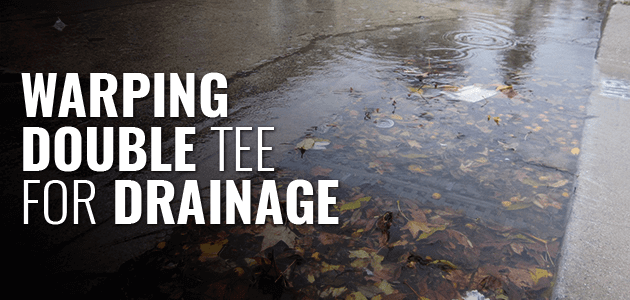
Important to the performance of parking garages is the need for drainage of surface water from rain and snow on the top level directly exposed to the weather, and by wind-driven rain and melt off from slush and snow carried into the parking garages by vehicles at the lower levels. Precast, prestressed parking structures are no different, but they do introduce a concept that is somewhat unique for the design professional to consider – the concept of warping.
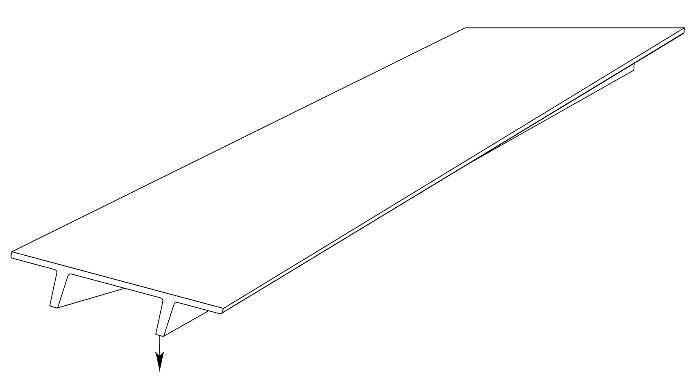
Warping is the result of taking a linear member such as a double tee and introducing a twist to lower one of the corners. While this might seem like an extreme procedure it is quite normal. Imagine a 12’-0” wide x 60’-0” long double tee that is bearing normally at the ends of its four stems, and that all bearing elevations are equal. Then suppose one of the four bearing points is removed, allowing the corner of the double tee to settle down under its own weight where the bearing was removed. This is not hard to imagine. There is a point at which the corner settles with minimal or no cracks, after which additional settlement will inevitably result in cracks. This distortion is graphically exaggerated in the sketch above.
Unlike closed sections such as solid slabs, double tees take advantage of the torsional flexibility inherent with open sections, allowing them to be warped while being erected to achieve drainage. Studies have shown that double tees ≥ 50’ long are sufficiently flexible to permit being warped 1% to 1.5% across the width, the equivalent of about 1½” to 2” across a 12’-0” wide double tee. To achieve positive drainage and avoid ponding water it is necessary to establish minimum slopes in two directions toward the floor drains. This is commonly detailed at 1.5% as measured across the diagonal, though 1% has been accepted as an absolute minimum after construction tolerances are considered. Shown below are sketches of three common bay spaces of 48’-0” x 60’-0”, 36’-0” x 60’-0”, and 24’-0” x 60’-0” combining these concepts.
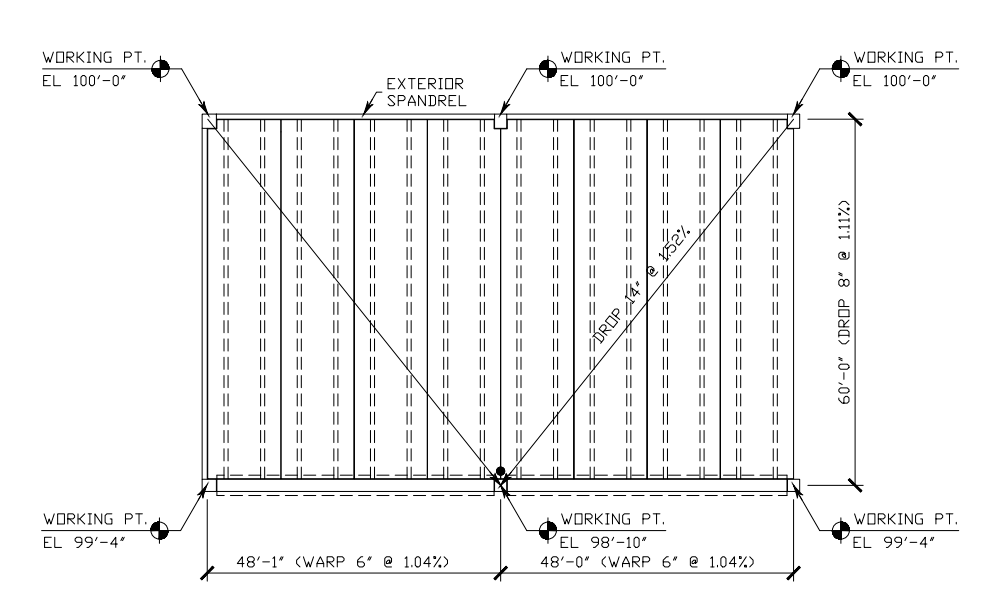
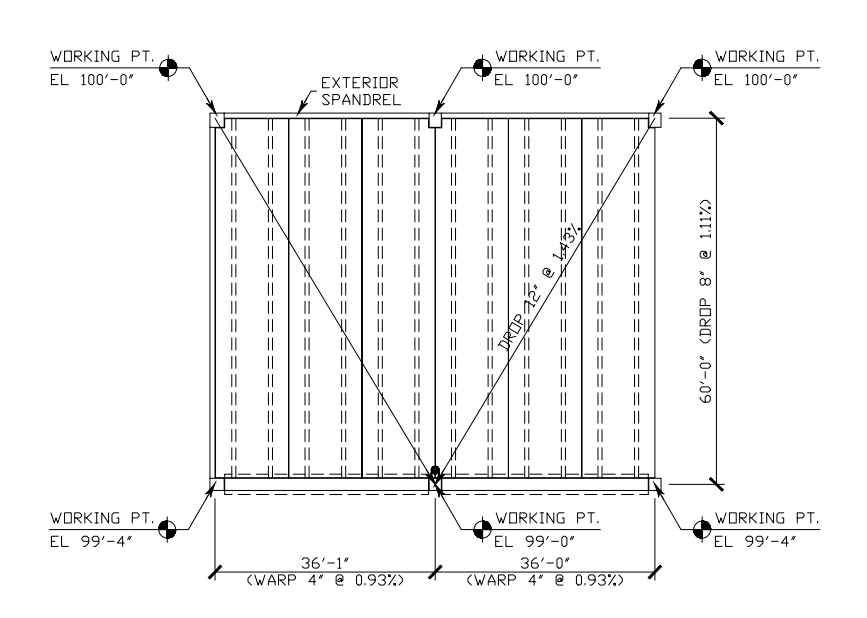
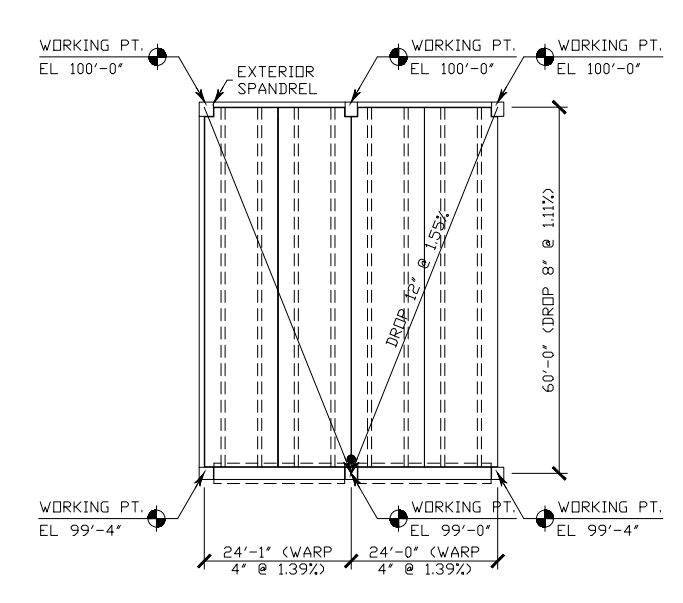
There are a few other factors to keep in mind when establishing the drainage pattern…
- The International Code Council Standard Accessible and Usable Buildings and Facilities (ICC A117.1) prescribes that ADA accessible parking on the “flat” parking surfaces must be < 2% slope.
- The drainage pattern selected is to be reflected on all levels, including the ground floor, so as not to compromise the headroom clearance prescribed by the International Building Code (IBC) as 7’-0” for typical parking areas and 8’-2” for ADA Van-Accessible parking spaces. This also simplifies the plumbing riser layout. It is imperative, therefore, when the drainage pattern is shifted for whatever reason at the various levels that a check is made on the resulting headroom clearances.
- Like most prestressed flexural members double tees have an inherent camber due to the eccentric prestressing force needed to support the gravity loads. It is not uncommon for 60’-0” long double tees to experience about 2” of long-term camber for the life of the parking structure, especially for upper level members that are designed to carry both vehicular traffic and snow. So that water does not become ponded at the high point it is necessary to provide enough “fall” to overcome the end rotation due to camber. For example, each of the three sketches shown above show a “fall” of 8” along the 60’-0” double tee, resulting in an end rotation of (8 in)/(60 ft)(12 in/ft) = 0.0111 radians. 2” of camber in a parabolic arc results in an end rotation of (384/5)(2 in)/(24)(60 ft)(12 in/ft) = 0.0089 radians ≤ 0.0111 radians, therefore OK. This example shows the importance of detailing a minimum “fall” of 8” along a 60’-0” double tee.
- Greater care needs to be taken when attempting to warp double tees less than 50’-0” long. While there are no definitive criteria regarding the degree of acceptable warping for shorter members, one possibility is set limits based upon L4, since that is a key factor in the deflections of free ends of fixed cantilevers. It can be argued that this approach is desirably conservative since the far end of the double tee being warped is not fixed, but free to rotate. Assume, for example, that the double tee being evaluated is only 12’-0” x 24’-0”. Based upon these assumptions the warp should be limited to about (12 ft)(12 in/ft)(0.015)(244/504) = 0.115”. This is only about ⅛”, which is frankly too little to detail and construct with any reasonable degree of accuracy. On the other hand, a double tee that is 12’-0” x 42’-0” might be able to tolerate about (12 ft)(12 in/ft)(0.015)(424/504) = 1.075”, which is a measurable quantity.
Nitterhouse Concrete Products, Inc. in Chambersburg, PA, is a family-owned company serving the construction industry since 1923. Give us a call at 717-267-4505 or contact us online for information on more quality precast, prestressed products to meet your design and construction needs.
Contact Nitterhouse Concrete Today



